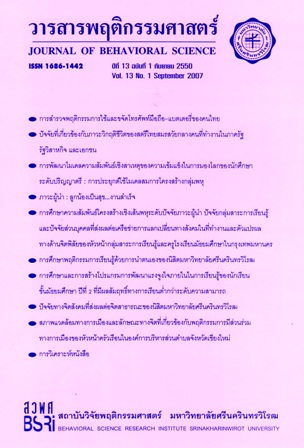ปัจจัยที่เกี่ยวข้องกับภาวะวิกฤติชีวิตของสตรีไทยสมรสวัยกลางคนที่ทำงานในภาครัฐ รัฐวิสาหกิจ และเอกชน (Factors Related to Midlife Crisis of Married Thai Women Working in Government, State- Enterprise, and Private Sector)
Abstract
This study is an correlational research. The study has the following objectives; a) analyzing the relationships between factors related to midlife crisis and exploring the predictive factors of midlife crisis b) comparing midlife crisis of Married Thai Women having difference of demographic and sectors , and c) investigating the interaction between observed variables in each factor influencing the perceived of midlife crisis. The sample consists of married Thai women working in the government, the state- enterprise, and the private sector in Bangkok and Periphery. The ages of participants ranged between 35-55 years old. Each participant had at least 1 child. The sample consists of 1,375 persons. The measuring instrument used for this research is a 195 items six-scaled questionnaire with Cronbach’s alpha between 0.765 and 0.953. SPSS for windows v.11 is used for data analyzing. Results indicated the presence of 4 factors; Personal factor, Family factor, Working factor and Urban-society factor. All factors were found to have an influence on self-perception of life crisis. Thus, All factors could be predictable 79.2% (R2= 0.792). High neuroticism had a greats impact on life crises when lower income of families, fewer family member, lower family support, lower commitment to Buddhism within family, lower colleague and boss support, and higher job ambiguity.
บทคัดย่อ
การวิจัยนี้เป็นการวิจัยเชิงสหสัมพันธ์ โดยมีวัตถุประสงค์ เพื่อศึกษาวิเคราะห์ความสัมพันธ์ระหว่างปัจจัยที่เกี่ยวข้องกับภาวะวิกฤตชีวิตของสตรีไทยสมรสวัยกลางคนและค้นหาปัจจัยสำคัญในการทำนายภาวะวิกฤตชีวิตเปรียบเทียบภาวะวิกฤตของสตรีไทยสมรสที่มีลักษณะทางชีวสังคมที่ต่างกัน พร้อมทั้งศึกษาการมีปฏิสัมพันธ์ร่วมระหว่างตัวแปรในแต่ละกลุ่มปัจจัยที่มีต่อภาวะวิกฤตของสตรีไทยสมรส กลุ่มตัวอย่างได้แก่ สตรีไทยสมรสซึ่งทำงานในหน่วยงานภาครัฐ รัฐวิสาหกิจและเอกชนในเขตกรุงเทพมหานครและปริมณฑล ที่มีอายุ 35 - 55 ปี และมีบุตรอย่างน้อย 1 คนรวมจำนวน 1,375 คน ทำการศึกษาตัวแปรในกลุ่มปัจจัยด้านบุคคล ด้านครอบครัว ด้านการทำงานและด้านสังคมเมือง และตัวแปรผลคือ ภาวะวิกฤตชีวิต เครื่องมือที่ใช้เป็นแบบสอบถามประมาณค่า 6 ระดับ รวม 195 ข้อ มีค่าสัมประสิทธิ์ความเชื่อมั่นของครอนบาคอยู่ระหว่าง 0.765 – 0.953 และทำการวิเคราะห์ข้อมูลด้วยค่าสหสัมพันธ์ การถดถอยพหุคูณและความแปรปรวนแบบสามทาง ด้วยโปรแกรม SPSS for windows v.11 ผลการวิจัย พบว่า ปัจจัยทั้ง 4 ด้านคือด้านบุคคล ด้านครอบครัว ด้านการทำงาน และด้านสังคมเมือง มีผลต่อกับการรับรู้ภาวะวิกฤตชีวิตของสตรีไทยสมรสวัยกลางคน ดังนั้นปัจจัยทั้งหมดสามารถทำนายการรับรู้ภาวะวิกฤตชีวิตได้ร้อยละ 79.2 (R2=0.792) อย่างมีนัยสำคัญทางสถิติที่ 0.05 และถ้าสตรีไทยสมรสวัยกลางคนที่มี บุคลิกภาพแบบหวั่นไหวสูง จะส่งผลให้มีภาวะวิกฤตชีวิตยิ่งสูงขึ้นด้วยเมื่อสตรีไทยสมรสวัยกลางคนนั้นมี รายได้ทั้งหมดของครอบครัวต่ำ จำนวนสมาชิกที่อยู่ในครอบครัวมีน้อย การสนับสนุนจากครอบครัวต่ำ ความผูกพันทางศาสนากับครอบครัวต่ำ การสนับสนุนจากเพื่อนร่วมงานและผู้บังคับบัญชาต่ำ และความคลุมเครือในงานสูง
คำสำคัญ: ปัจจัย ภาวะวิกฤตชีวิต สตรีวัยกลางคนDownloads
How to Cite
Issue
Section
License
Behavioral Science Research Institute, SWU
114 Sukhumvit 23, Bangkok 10110, Thailand.
Tel.02-649-5000 # 17600


